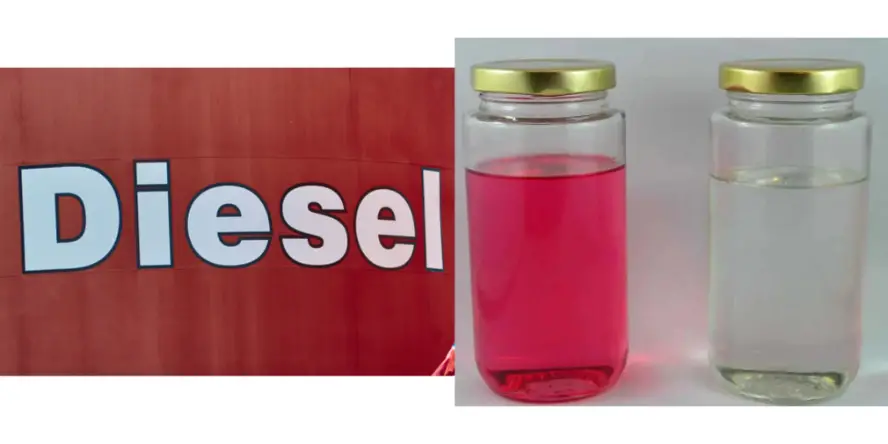
If you live in a Country other than the US, Europe, or Canada, you may never have heard of the term Red Diesel. As you’ll deduct from the name, this is a type of diesel fuel.
Although freely available in many countries, red diesel may only be used for specific applications as stipulated in each country or state.
Mixing red and normal diesel is physically possible as the fuels are virtually identical. It’s, however, illegal to use red diesel for unintended purposes. Red-dyed diesel is not taxed, which makes it cheaper to buy for qualifying industries such as farming, construction, and off-road vehicle use.
We’ve researched the question and found definitive answers as to why you physically can mix red and normal diesel but also why you should not do so to stay on the right side of the law.
Mixing Red and Normal Diesel
Red diesel and normal diesel, also called white diesel, can be mixed and used in diesel engine vehicles and generators. In the US, diesel fuel with a high Sulphur content is stained with a red dye to identify the fuel quickly.
Adding red diesel to normal diesel will run your car but may well get you into a whole lot of unintended trouble. Mixing low Sulphur and high Sulphur fuels occasionally will not harm an engine. So, normal diesel can be added safely if you’re running low on red diesel when you’re off-roading. More on this later.
Engines designed for low Sulphur diesel fuel may perform less efficiently when running on high Sulphur diesel. Low Sulphur diesel has better combustion properties, burns cleaner than high Sulphur fuel, and is more environmentally friendly.
High Sulphur fuels are not as clean as low Sulphur fuels meaning engine lubricants don’t last as long as they would with low Sulphur diesel. Lubricant degradation means additional engine servicing, leading to increased overall running costs.
What Is The Difference Between Red And Normal Diesel?
Apart from the color difference between red and white diesel, there’s no chemical difference between the fuels in Europe and other countries. In the US, red diesel has a high Sulphur content as opposed to white or regular diesel’s low or ultra-low Sulphur content.
The most significant difference between the fuel is the intended purpose for which the fuel is provided. Red-dyed diesel is tax-exempt in some countries or qualifies for rebates in others. The rebate makes the red diesel cheaper to buy for the end user, but there are conditions attached.
Red diesel is only legal for off-road vehicles such as those used for farming and construction. In some countries, it includes commercial fishing operations using diesel-powered vessels. In the US, off-road vehicles are included in qualifying uses.
Red diesel is exempted (rebated) under section 4082 of the Internal revenue code and was implemented along with the fuel duty in 1928. The fuel duty is intended to be a motoring tax and a duty on gas oil mainly used in heating.
It’s been a requirement since 1961 for gas oil and diesel to be marked with a red dye to facilitate easy identification of the fuels. Interestingly, fuel destined for use in official US Government vehicles is marked with blue dye.
Does Red Diesel Damage Your Engine?
Red diesel is basically the same as regular or white diesel. It is, therefore, safe to use in any diesel engine vehicle or generator, provided the necessary legal requirements are fulfilled.
What Happens If You Use Red Diesel?

Anyone can purchase Red diesel if they have a valid reason, such as requiring the fuel for heating or power domestic power generation units such as generators.
The onus rests on the end user to use the red-dyed diesel for its intended use. Should someone deliberately use red diesel in their car for highway use to save a buck, the infringement is considered tax evasion, which is a severe offense.
Suppliers of red diesel must be registered with the appropriate authority and be obliged to report any suspicious diesel use to the relevant authority.
Using red diesel in your vehicle even once will stain the internal components such as the fuel tank, fuel lines, and diesel pump, making the identification of illegal use of the fuel easy to detect.
Significant fines or even jail time are associated with the illegal use of red diesel.
Can Red Diesel Damage Your Car?
Red diesel fuel is virtually identical to regular or white diesel. The dye used to color the diesel is harmless to your engine and fuel system components, other than staining the internal components of the fuel system red.
The dye burns cleanly, do not emit harmful gasses into the atmosphere and is environmentally friendly.
Can Red Diesel-Powered Vehicles Be Used On Highways?
The use of red diesel is limited to vehicles that are used off-road and do not pay road taxes. These include agricultural machinery such as tractors. In construction, TLBs, bobcats, diesel-powered concrete mixers, generators, and the like are not permitted to drive on public roads.
Should a vehicle belonging to a construction company be road legal, such a vehicle will not be permitted to use red diesel.
Having said the above, fuel supply shortages caused by natural disasters or states of emergency do occasionally force states to allow the use of red diesel in vehicles used on highways, although this is not the norm. The diesel price is adjusted to include the regular diesel taxes in such instances.
Conclusion
Red-dyed diesel and normal diesel have the same chemical composition other than the red chemical marker or dye found in red diesel. As such, red and normal diesel can be mixed, allowing the engine to function normally.
The problem with mixing red and normal diesel for vehicles driving on highways is that using red diesel in an unauthorized vehicle is illegal and can lead to significant fines and even jail time for the person doing so.
